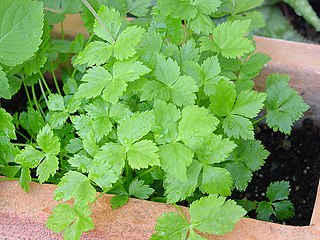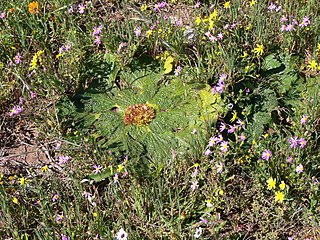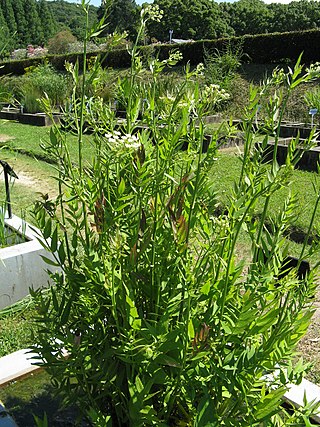
Apiaceae or Umbelliferae is a family of mostly aromatic flowering plants named after the type genus Apium and commonly known as the celery, carrot or parsley family, or simply as umbellifers. It is the 16th-largest family of flowering plants, with more than 3,800 species in about 446 genera, including such well-known and economically important plants as ajwain, angelica, anise, asafoetida, caraway, carrot, celery, chervil, coriander, cumin, dill, fennel, lovage, cow parsley, parsley, parsnip and sea holly, as well as silphium, a plant whose identity is unclear and which may be extinct.

The Araliaceae are a family of flowering plants composed of about 43 genera and around 1500 species consisting of primarily woody plants and some herbaceous plants. The morphology of Araliaceae varies widely, but it is predominantly distinguishable based on its woody habit, tropical distribution, and the presence of simple umbels.

Conium is a genus of flowering plants in the family Apiaceae. As of December 2020, Plants of the World Online accepts six species.

Apium is a genus of about 20 species of flowering plants in the family Apiaceae, with a subcosmopolitan distribution in Europe, Asia, Africa, South America and Australia. They are medium to tall biennials or perennials growing up to 1 m high in the wet soil of marshes and salt marshes, and have pinnate to bipinnate leaves and small white flowers in compound umbels. Some species are edible, notably Apium graveolens, which includes the commercially important vegetables celery, celeriac and Chinese celery. Apium bermejoi from the island of Menorca is one of the rarest plants in Europe, with fewer than 100 individuals left.

Cryptotaenia, or honewort, is a genus of herbaceous perennial plants, native to North America, Africa, and eastern Asia, growing wild in moist, shady places.
Annesorhiza is a genus of flowering plant in the Apiaceae, with about 12 to 15 species. It is endemic to southern Africa. Various species of the genus are noted for their content of aroma compounds and have a traditional culinary usage. Some species are notable for their content of phenylpropene derivatives such as nothoapiole.

Arctopus is a genus of flowering plant in the Apiaceae, with three species. It is endemic to southern Africa. The genus name means "bears foot" in reference to the curious growth habit, resembling a large footprint. The species were used in Khoisan medicine and adopted by the early settlers who gave them the Afrikaans name of sieketroos They are atypical members of the Apiaceae with the leaves growing flat on the ground and are dioecious, having separate male and female plants.

Berula is a cosmopolitan genus of flowering plants in the family Apiaceae, whose species are known as water parsnips, as are some other plants in Apiaceae such as Sium latifolium and Sium suave. It is easily confused with the highly toxic water hemlock.
Capnophyllum is a genus of flowering plant in the Apiaceae. It contains four species. They are endemic to southern Africa, particularly near the Cape of Good Hope.

Erigenia bulbosa, also known as harbinger of spring or pepper and salt, is a perennial plant in the family Apiaceae. E. bulbosa is the only species in the genus Erigenia and tribe Erigenieae. This plant is known as harbinger of spring because it is one of the earliest blooming native wildflowers of rich forests in the mid-latitude United States. Throughout most of its range it blooms from late February through early April.

Cymopterus is a genus of perennial plants in the family Apiaceae native to western North America. They are commonly known as the springparsleys. They are mostly stemless, taprooted perennial herbs with leaves at ground level and flowering scapes bearing yellow, white, or purple flowers.
Marlothiella gummifera is a species of flowering plant in the family Apiaceae, and the only species in the monotypic genus Marlothiella. It is endemic to Namibia, where its natural habitats are rocky areas and cold desert. It is also the only genus in the tribe Marlothielleae, of the subfamily Apioideae.

Sium is a genus of flowering plants in the family Apiaceae. It is widely distributed across Europe, Asia, Africa, and North America. Plants of this genus are commonly called water parsnips.

Lilaeopsis is a genus of several species of flowering plants in the family Apiaceae. Known commonly as grassworts. L. brasiliensis is used as a decorative plant for the foreground of aquaria.

Sium suave, the water parsnip or hemlock waterparsnip, is a perennial wildflower in the family Apiaceae. It is native to many areas of both Asia and North America. The common name water parsnip is due to its similarity to parsnip and its wetland habitat. The alternate common name hemlock waterparsnip is due to its similarity to the highly poisonous spotted water hemlock.

Helosciadium nodiflorum, fool's watercress, is a flowering plant found in ditches or streams, as well as fresh and brackish-water wetlands native to western Europe. It is not poisonous to humans but it could be easily confused with the allegedly poisonous lesser water parsnip.
Dasispermum are a genus of flowering plants in the family Apiaceae, native to coastal area of southern South Africa. Short-lived perennial or annuals, they are low-lying, often sprawling herbs with succulent or semi-succulent leaves, adapted to the dry, salty conditions of the littoral areas where they grow.
Hermas is a genus of flowering plant in the family Apiaceae, native to Cape Provinces of South Africa.












